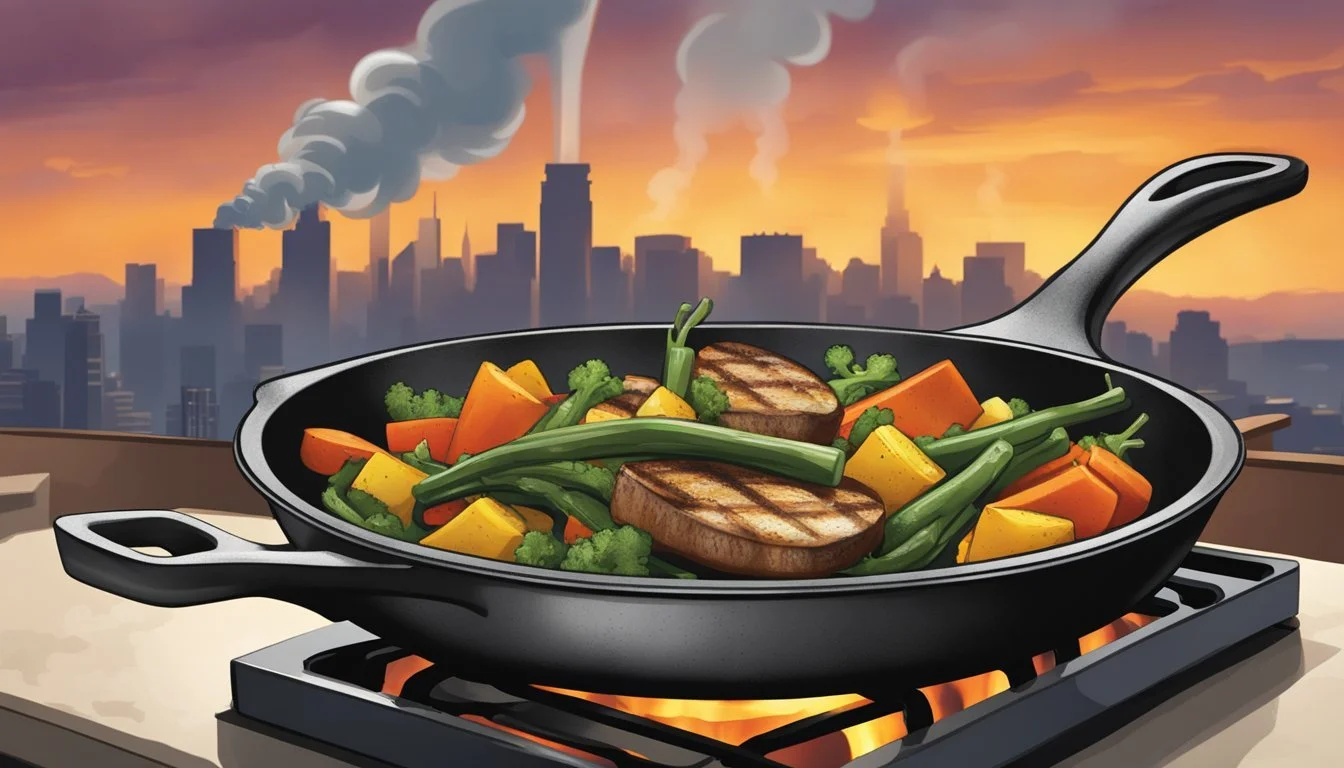Cast Iron in the City
Elevating Urban Cuisine with Timeless Cookware
Cast iron cookware has made a remarkable resurgence in urban kitchens, where its enduring qualities offer a touch of rustic charm to modern cooking practices. As city dwellers increasingly seek the simplicity and authenticity of traditional cooking methods, cast iron pans and skillets have transitioned from countryside kitchens to high-rise apartments. The versatile nature of cast iron makes it an ideal choice for a variety of dishes, from searing steaks to baking the perfect cornbread.
The appeal of cast iron in the city stems not only from its functionality but also from its ability to improve with age. Unlike more contemporary non-stick cookware, a well-seasoned cast iron skillet develops a natural non-stick coating over time, enhancing flavor and making each meal a testament to the cook's culinary journey. This cookware is recognized for its unparalleled heat retention and even distribution, ensuring that meals are cooked uniformly.
Urban cooks appreciate the cast iron's transition from stovetop to oven, allowing for experimental cooking and creative recipes. The cookware's durability ensures it can withstand high temperatures and varied cooking techniques, proving indispensable for the urbanite who enjoys adding a rustic twist to their gastronomic repertoire. Whether it's a rooftop dinner party or a cozy meal for one, cast iron cookware has secured its place as a beloved staple in the contemporary urban kitchen.
Cast iron cookware has found its place in the bustling energy of city life, seamlessly blending its timeless allure with modern culinary trends. The development of a well-seasoned cast iron patina is a testament to the enduring appeal and reliability of these kitchen essentials, making them a staple in urban kitchens. From the precision of Dutch oven cooking to the art of grilling showcased in the comprehensive cast iron grilling guide, these cookware pieces offer city dwellers a wide array of culinary possibilities.
The challenges presented by the cast iron meal challenge inspire creativity and innovation among urban cooks, further elevating the status of cast iron in the culinary landscape. The convenience and charm of mini cast iron cookware provide the perfect canvas for crafting individual portions and visually appealing presentations, catering to the fast-paced urban lifestyle.
In the midst of city living, a cast iron wedding gift symbolizes enduring strength and craftsmanship, offering a cherished tool for every culinary adventure shared. Embracing the versatility and durability of cast iron cookware sets, urban residents seamlessly blend tradition with contemporary demands, making cast iron a beloved and enduring choice for city living.
The Fundamentals of Cast Iron
In the bustling streets of the city, cast iron cookware bridges the gap between modern living and time-honored culinary practices. This section explores cast iron's rich history, the range of cookware available, and the merits of introducing it to urban kitchens.
History and Tradition of Cast Iron
Cast iron cookware has a storied legacy, rooted in centuries-old techniques. These durable pieces have been valued for generations, first appearing in China around the 5th century B.C. Skillets and Dutch ovens, made from this tough material, became essentials in the kitchens of the past and are now experiencing a resurgence among contemporary cooks who appreciate the blend of tradition and functionality.
Types of Cast Iron Cookware
Cast iron comes in various shapes and sizes, catering to a plethora of cooking needs:
Skillets: Ideal for searing and frying, they provide even heating and a non-stick surface when properly seasoned.
Dutch Ovens: With their tight-fitting lids, they're perfect for slow-cooking, braising, and stewing.
Griddles: Their large, flat surfaces are suitable for cooking pancakes, pizzas, and other skillet-friendly foods evenly.
Each form of cast iron cookware serves specific purposes, offering robustness and versatility for any culinary task.
Benefits of Cooking with Cast Iron
Cooking with cast iron offers numerous advantages:
Even Heating: Iron's ability to evenly disperse heat makes it a preferred choice for methods requiring consistent temperatures.
Health Aspect: A minor amount of iron leaches into the food, potentially providing dietary benefits, although this should not be the sole method of iron supplementation.
Longevity: When maintained with proper seasoning, cast iron cookware can last for decades, often becoming more non-stick over time.
The adaptability of cast iron makes it a dedicated ally in the urban kitchen, where traditional cooking methods can be celebrated in the modern culinary landscape.
Getting Started with Cast Iron
Incorporating a cast iron skillet into urban cooking brings a rustic twist to any recipe. They need to understand the selection process, how to season their skillet, and the essential tools required for maintenance and cooking.
Selecting Your First Piece
When choosing their first cast iron skillet, one should consider size and weight. A 10- to 12-inch skillet is versatile for various recipes and not overly heavy. They should check for a smooth surface which aids in even cooking and non-stick properties. It's important to note that new cast iron comes pre-seasoned, allowing for immediate use.
Understanding Seasoning
Seasoning is the process of baking oil onto the cast iron to create a natural, non-stick coating. They should heat it slightly before applying a thin layer of oil, such as canola or vegetable oil. They then bake the skillet upside down in the oven at 450°F to 500°F for one hour. This process builds up the distinctive black patina look that enhances the skillet’s non-stick quality.
Seasoning Steps:
Heat the skillet.
Apply a thin layer of oil with a paper towel.
Place it upside down in a preheated oven.
Bake for one hour.
Let it cool in the oven.
Essential Tools and Accessories
When cooking with cast iron, certain tools enhance the experience and maintain the skillet's condition:
Heat-resistant handle mitt: Protects hands from the high heat retained by cast iron.
Stiff brush: Cleans the skillet without damaging the seasoning.
Metal spatula: A flat-edged metal spatula helps keep the cooking surface smooth.
Chainmail scrubber: Safely scrubs away stuck-on food.
Cooking with cast iron often involves high temperatures and requires fat like oil or butter for the best results. These tools ensure that the cast iron remains well-maintained and the food is cooked to perfection.
Cooking Techniques
Cooking with cast iron skillets and pans brings a delightful rustic twist to urban kitchens. Mastering various techniques ensures food is cooked evenly and acquires the desired texture and flavor.
Stovetop Mastery
On the stovetop, chefs should begin by pre-heating their cast iron skillet to establish a uniformly hot surface, crucial for achieving a perfect sear on meats or vegetables. When cooking acidic foods, it is prudent to use a skillet that is well-seasoned to prevent reactions with the iron. For recipes requiring a transition from stovetop to oven, cast iron excels due to its ability to withstand high temperatures.
Pre-heat: Always pre-heat the skillet on medium heat for at least 5-10 minutes.
Oil Selection: Choose an oil with a high smoke point to avoid burning.
Oven Baking Basics
Baking with cast iron in the oven offers remarkable results, particularly for breads and pizzas where a crispy crust is desired. Prior to introducing dough to the skillet, it is essential to pre-heat the cast iron to ensure that the crust begins to form the moment dough makes contact.
Pre-heat: Place the skillet in the oven during the pre-heating stage.
Temperature: Bake at the recommended recipe temperature, adjusting for cast iron if necessary.
Alternative Cooking Surfaces
Cast iron is versatile and can be used on a variety of cooking surfaces, including grills and over an open flame. The seasoned surface is excellent for rustic cooking, imparting complex flavors and retaining the optimal amount of heat regardless of the setting.
Grill Compatibility: Cast iron skillets are effective on both charcoal and gas grills.
Outdoor Cooking: When using over an open flame, stabilize the skillet with a solid support to ensure even cooking.
Recipe Repertoire
The urban kitchen embraces the versatility of cast iron with a collection of recipes that bring a touch of rustic charm to city living. Each recipe highlights the skillet's ability to cook a vast array of dishes, from morning meals to sweet endings.
Breakfast Specialties
Classic Skillet Cornbread: A staple in cast iron cooking, this cornbread recipe becomes the cornerstone of any breakfast table. It makes use of simple ingredients like cornmeal, flour, and baking powder, which help it rise to the occasion, offering fiber and a homemade touch.
Ingredients: Cornmeal, all-purpose flour, baking powder, eggs, milk
Preparation: Combine dry ingredients, mix in wet ingredients, pour into a preheated skillet, and bake until golden.
Savory Skillet Meals
Bruschetta Chicken Pasta: This skilled blend of old-world charm and urban simplicity sees tomatoes and basil transformed into a fresh sauce, perfect for topping seared chicken and pasta. The cast iron skillet ensures even cooking, while its heat retention makes it ideal for simmering sauces.
Ingredients: Chicken breasts, ripe tomatoes, fresh basil, garlic, olive oil, pasta
Cooking: Sear chicken, prepare tomato basil sauce in the same skillet, toss cooked pasta in the skillet, and serve.
Baked Delights and Desserts
Rustic Fruit Galette: The cast iron skillet excels in baking, as seen in this dessert where fruit, flour, and a touch of sugar create a sweet, fiber-rich galette. The skillet's even heat distribution is key to achieving a flaky, golden crust.
Ingredients: Seasonal fruits, all-purpose flour, sugar, butter, a pinch of salt
Baking: Roll out dough, place fruit mixture in the center, fold edges, and bake until the crust is crisp and golden.
Maintaining Your Cast Iron
Proper maintenance ensures the longevity and performance of cast iron cookware. Users should prioritize regular cleaning, address any problems promptly, and re-season their cookware to retain its non-stick surface.
Cleaning and Care
Routine Cleaning: After cooking, let the cast iron skillet cool. Rinse it with hot water, using a non-metallic brush or sponge to remove food particles. Avoid using soap or detergents. For tough residue, boiling water in the skillet can loosen it. Thoroughly dry the skillet with a towel or heat it over low heat on the stove to evaporate moisture.
Seasoning Application: While the skillet is still warm, apply a thin layer of oil or fat to the entire surface, including the exterior and handle. Suitable oils include vegetable oil, canola oil, or flaxseed oil. The oil should be baked into the cookware's surface, either in the oven or on the stovetop, to maintain the seasoning layer that contributes to its non-stick properties.
Troubleshooting Common Issues
Rust Removal: If rust appears, scrub the area with a mixture of coarse salt and water using a potato or scrubber. Rinse and thoroughly dry the cookware. It’s important to re-season the skillet after rust removal to protect it from further rusting.
Sticking Food: Increase the frequency of oiling and heating the skillet after washing to enhance the seasoning. Use a little extra oil or fat when cooking, especially when preparing sticky foods like eggs.
Re-seasoning Your Cookware
Re-seasoning restores the skillet's surface when it becomes dull or damaged. First, clean the skillet as per the routine care mentioned earlier. Then apply a thin, even layer of oil to the skillet. Heat the skillet in the oven at 375-400°F (190-205°C) for an hour, placing it upside down on the oven rack with foil or a baking sheet below to catch drips. Allow the skillet to cool in the oven after heating. Re-seasoning can be done as needed or every few months to ensure optimal performance.
The Cultural Impact of Cast Iron
Cast iron cookware has woven itself into the fabric of culinary tradition, becoming a mainstay in both historical and contemporary cooking practices. The material's enduring presence and utilitarian value have fostered a unique cultural impact highlighted through modern media and community gatherings.
Cast Iron in Modern Media
In recent years, cast iron has seen a resurgence in popularity, partly fueled by its robust presence on social media platforms. On Instagram and Facebook, vivid imagery of well-seasoned skillets and the enticing dishes they contain garner thousands of likes and shares. YouTube channels dedicate series to the proper care of cast iron and the endless recipes that take advantage of its even heating and heat retention properties. The visual appeal of cast iron cookware, coupled with its traditional roots, makes it ideal content for media that prizes both aesthetic and authenticity.
Community and Cast Iron Cooking
Communities often come together through shared experiences, and cast iron cooking is no exception. Individuals and members of cast iron cooking groups on platforms like Facebook revel in the exchange of recipes, maintenance tips, and the communal joy of cooking in cast iron. Such groups have transformed the individual act of cooking into a collective experience, providing spaces for both novices and veterans to connect over a shared appreciation for this durable medium. Tradition is palpable during community events like cookouts and potlucks, where cast iron's ability to go from stovetop to campfire offers versatility cherished by outdoor and home chefs alike.
Advanced Cast Iron Techniques
Navigating the intricacies of cast iron cooking can elevate the urban chef's culinary game, particularly when exploring the use of acidic foods and harnessing the robust qualities of cast iron for grilling and outdoor cooking.
Cooking Acidic Foods
Cooking acidic foods in cast iron can be intimidating due to concerns over metallic flavors and potential damage to the pan's seasoning. However, when done correctly, it infuses dishes with a unique depth of flavor. Short-term cooking of acidic foods like tomatoes or wine-based sauces is acceptable, as it generally does not harm the seasoned patina. Chefs should avoid long simmers of acidic ingredients, especially in newer pans, to preserve the non-stick surface and prevent iron leaching.
Short Duration: Limit acidic cooking to under 30 minutes.
Well-Seasoned Pans: Utilize pans with a robust seasoning built up over time.
Grilling and Outdoor Use
Cast iron's versatility shines in grilling and outdoor cooking, where it imparts a distinct sear unmatched by other cookwares. It's perfect for the urban cook looking to bring a rustic twist to their balcony or rooftop grilling. One can obtain an even heat distribution and retain high temperatures even after adding food to the pan. Cast iron is also ideal for camping, enduring direct exposure to campfires and withstanding rugged conditions without damage.
Preheat Process: Start with a low flame and gradually increase to the desired temperature.
Maintenance Post-Grill: After use, let the pan cool naturally, clean it promptly, and re-season if necessary to maintain its non-stick properties.
By mastering these advanced techniques, cooks can expand their cast iron repertoire and enjoy the full range of culinary possibilities this traditional cookware has to offer in an urban setting.
Further Exploration
Venturing further into the art of cooking with cast iron in an urban setting opens the door to enriched culinary skills and an expansive repository of resources. The city dweller can grow their expertise through structured learning and a wealth of digital content.
Classes and Workshops
Many cities offer classes and workshops tailored to enhancing one’s prowess with cast iron cookware. These educational experiences range from beginner techniques to advanced culinary applications, often held at local cooking schools or kitchen supply stores. Participants learn to season their skillets correctly, master heat distribution, and cook an array of recipes. Those looking to elevate their cast iron cooking game should seek out these opportunities for hands-on learning.
Books and Online Resources
For those who prefer self-guided learning, numerous books and online resources are available. Amazon boasts a selection of best-selling books such as Cook It In Cast Iron which provide readers with recipes and techniques designed to maximize the use of their cast iron skillets. Additionally, America’s Test Kitchen offers a well-reviewed resource for crafting the perfect rustic Italian loaf.
Online platforms like YouTube are treasure troves of tutorials and cooking shows dedicated to cast iron cooking. Channels run by seasoned chefs and culinary enthusiasts regularly post videos that illustrate everything from the basics of seasoning to crafting entire meals using cast iron cookware. This medium not only caters to visual learners but also gives viewers an immediate glimpse into the results they can achieve following the shared recipes and methods.
Conclusion
Cast iron cookware offers an excellent bridge between city sophistication and rustic charm. Its durability and versatility make it suitable for both contemporary urban kitchens and outdoor, countryside cooking. Cast iron is more than a trend; it’s a time-tested material that has proven its worth in kitchens for generations.
Maintenance and care: To maintain the non-stick properties of cast iron, one should regularly season the surface. Applying a thin layer of oil after cleaning prevents rust and enhances its cooking performance.
Heating qualities: Cast iron's ability to retain and evenly distribute heat makes it ideal for a range of recipes, from searing steaks to baking artisan bread.
Flavor enhancement: The cookware’s seasoned surface contributes to flavor development in foods, offering a unique taste experience that cannot be replicated with other materials.
Eco-friendly choice: Cast iron is eco-friendly. With its long lifespan, there is less need for frequent replacements, making it a sustainable option for the environmentally conscious.
In urban kitchens, cast iron stands as a nod to the past, while comfortably fitting into the modern culinary landscape. Its robust nature and traditional feel provide an exceptional cooking experience, proving that some things better withstand the test of time.






